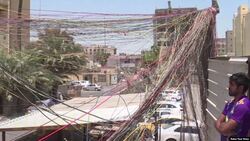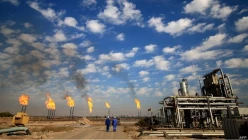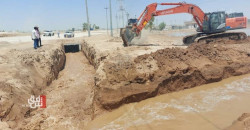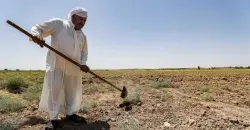Iraq's groundwater dilemma: Necessity, risks, and sustainable solutions
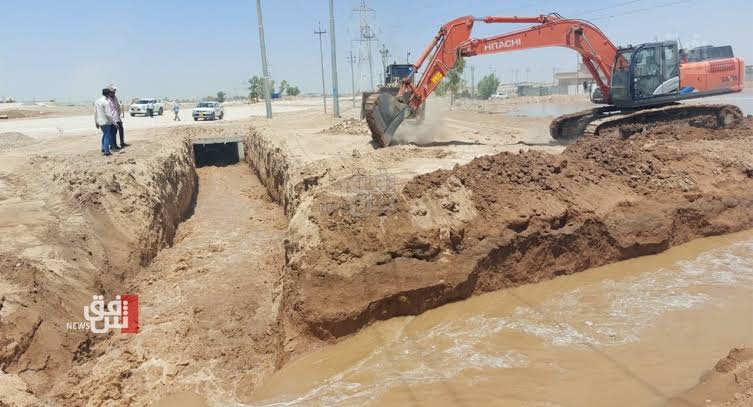
Shafaq News / While specialists caution against relying solely on groundwater for agriculture due to its severe immediate and long-term impacts, others advocate for conditions on its use, reserving it solely for emergencies and actual water needs, and promoting modern irrigation methods to optimize consumption.
Over recent years, Iraq has become one of the top five countries most affected by climate change globally. This has led to a 70% drought in agricultural lands, resulting in the displacement of residents to urban areas. Moreover, the Marshes have dried up, and rainfall levels have significantly declined.
On the other hand, Iraqi Prime Minister Mohammed Shia Al-Sudani affirmed last March that seven million Iraqis have been adversely affected by climate change. This accompanies the monopolization of freshwater resources by upstream countries (Turkey and Iran). Large dams constructed by these nations have withheld around 70% of Iraq's water share.
As a consequence of these collective circumstances, both the government and citizens have been compelled to turn to groundwater to compensate for the shortage in drinking and irrigation water.
Groundwater Risks
However, water resources expert, Tahseen Al-Mousawi, emphasized that the major mistake in using groundwater is its non-sustainability. Therefore, it should not be used in this random manner, which resulted in a loss of one meter of water during the previous season. The external and internal pressure on the Ministry of Water Resources seems to have led it to this action, which will have significant repercussions in the future.
Al-Mousawi affirmed that the excessive extraction of groundwater has dangerous effects both in the short and long term. Currently, the country has reached a stage of drought after four consecutive seasons, and for the past two seasons, the dead storage is being used for the first time in history.
He added that the empty water storage space is estimated at about 130-140 billion cubic meters. The three main dams, Mosul, Dokan, and Tharthar, are currently in critical condition, with their dead reserves being utilized.
As a result of this drought, agricultural areas have been lost, climate migration has exacerbated, and the fish wealth has plummeted to the point of extinction, especially in the Marshes and their associated loss of buffalo and birds.
He highlighted that what has worsened the crisis since 2003 is the reliance on halfhearted solutions as a strategic plan. The decision-makers in the country do not realize the seriousness of the water situation for the future.
Furthermore, both the Ministries of Agriculture and Water Resources have approved an agricultural plan for the winter season. It is the first of its kind in the country, relying mainly on groundwater to secure irrigation water. This comes amid significant challenges related to the state's ability to provide modern irrigation systems, which are now being sold to farmers at subsidized rates, following a plan aimed at reducing water consumption and abandoning outdated irrigation methods.
According to recent official data, the agricultural plan for the winter season 2023/2024 across Iraq's cities will rely on cultivating only 5.5 million dunams. The area cultivated using surface water (Tigris and Euphrates Rivers) will be approximately 1.5 million dunams, while the area cultivated using groundwater will be around four million dunams.
Iraq possesses five million cubic meters of renewable groundwater, which can be replenished by rainfall, in addition to an undisclosed strategic reserve quantity, although once utilized, it cannot be restored.
Terms of use
Iraq leads Arab countries in groundwater resources, reaching approximately 30 billion cubic meters, according to Zozan Kochar, Deputy Head of the Parliamentary Agriculture, Water, and Marshlands Committee. She emphasized that groundwater plays a vital role in land development, especially in areas where surface water cannot reach.
This groundwater, acting as an alternative to surface water, is used for agricultural, industrial, and human purposes based on the actual needs of those regions.
Kochar attributed the recent increase in reliance on groundwater to climate change, rainfall scarcity, global warming, and reduced water levels in the Tigris and Euphrates rivers due to decreased water releases from Turkey.
These circumstances, according to Kochar, have led to a widespread dependence on groundwater, especially in this season's agricultural plan following a 70% drought in agricultural lands. According to the plans of the Ministries of Water Resources and Agriculture, four million hectares are reliant on groundwater for cultivation.
Kogar suggested that groundwater use should be for emergencies and based on actual water needs, utilizing modern irrigation methods to optimize consumption. She called for a plan to store rainwater, snow, and floodwaters to mitigate harsh conditions, especially in the summer.
According to the parliamentary committee's vision, modern agriculture should be embraced, using drought-resistant crops that consume minimal water to preserve groundwater. Government institutions should collaborate for optimal water use, supporting farmers with loans or advances to purchase modern irrigation systems and sustain this crucial agricultural sector.
Last June, the Ministry of Agriculture announced interest-free loans with extended repayment periods of up to five years for farmers willing to invest in modern irrigation systems for their agricultural lands.
Moreover, a previous United Nations report on water security in the Arab region emphasized that 17 out of 22 Arab countries are currently facing water scarcity, with 12 already under the acute water poverty line, including Iraq.
The Water Stress Index predicted that Iraq will be riverless by 2040, and the waters of the Tigris and Euphrates will not reach their final destination in the Arabian Gulf.
It is noteworthy that the Water Stress Index is a measure of the scarcity of renewable freshwater available per person annually from the total available water resources for the region's population.
Iraq's total consumption rate for all needs is approximately 53 billion cubic meters annually, while it requires 70 billion cubic meters to meet its needs. Additionally, the quantity of river water during good seasons is estimated at about 77 billion cubic meters, and in drought seasons, it decreases to around 44 billion cubic meters.

